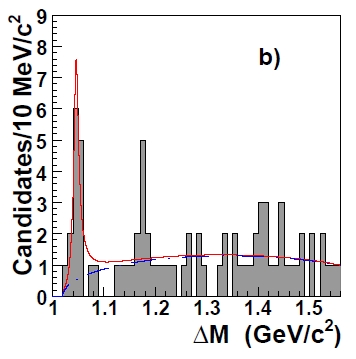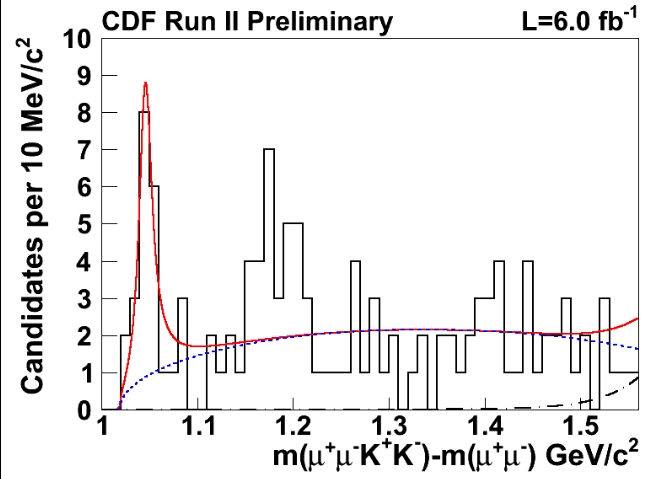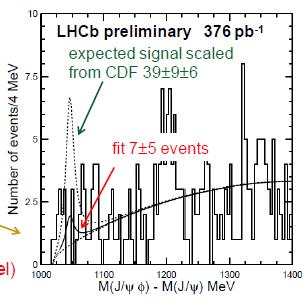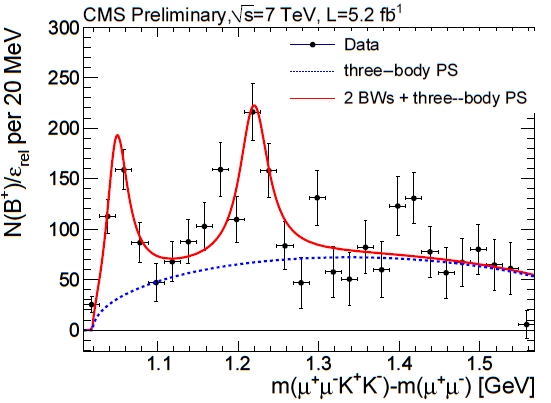Confused ? You have all rights to be. I will explain everything in good order, but be sure that the matter was puzzling not only for laymen but also for insiders: because the find was mysterious, not predicted by existing models, and potentially controversial.
B Decays and the CDF Claim
B mesons are particles composed of a bottom quark and a lighter anti-quark. If you pick a up antiquark and you couple with a b, you get a B meson of charge -1 (because the up antiquark has charge -2/3, and the bottom has charge -1/3); if instead you get a down quark together with the bottom one, you get a neutral B meson -called Bzero. Incidentally, there's a third frequent kind of B meson, which you can make with a b and an anti-s quark. In that case, too, you have a neutral B, but you call it "b-sub-s" meson, to distinguish it and clarify its quark content.
The search we are discussing today is one that arises in events where we produce, by hadron collisions, a B+ meson (or its anti-particle, the B-). B+ mesons live a considerably long life if compared to most other particles: about a picosecond and a half, ten to the minus twelve seconds. Formidably small time, and yet enough to travel a little bit -say of the order of a millimeter or so- before disintegrating into lighter bodies.
When B+ mesons decay, they can do in a variety of ways. The decays we are concerned with here are ones that produce a three-body final state: a J/psi meson, a phi meson, and a kaon. The J/psi is the particle discovered in 1974, a meson composed by a charm and an anti-charm quark orbiting one around the other; it has a mass of 3.1 GeV and it decays quite quickly, via the electromagnetic interaction, producing sometimes a pair of muons. The phi meson, instead, has a mass of 1.02 GeV and it is composed of a strange-antistrange quark pair; it decays even more quickly than the J/psi since its disintegration is mediated by the intense strong force, producing two charged kaons. Charged kaons, finally, are mesons composed of a strange and an up quark: one more such particle is produced by the B+ decay, in the case we are considering.
So all in all you have a B+ yielding two muons -from the J/Psi-, two kaons -from the phi- and a further kaon. Since all these particles are charged, one can reconstruct the total invariant mass of the system without having to worry about neutral particles having escaped: we use the inner tracker detector of our experiment (be it CDF or LHCb or CMS), and we are happy to "see" all that we need to see, in this case. That we haven't missed anything, on the other hand, is clear because the total mass of the system produces a clear peak at the correct mass of the B+ meson!
Also, note that this analysis would not be possible if the J/psi meson decayed to anything else than two muons: it is the muons that "trigger" the collection of a potentially very interesting event. The muons are easy to see and trigger on by the three detectors - physicists have long known that by collecting events with two muons, in fact, they automatically get very useful data samples.
So, what is the analysis that was performed first in CDF ? Well: it starts with hypothesizing that the three-body decay of the B+ into the J/psi, the phi, and the kaon is really a decay to two particles: a KaiYinium and a kaon. The KaiYinium then immediately decay to the J/psi and the phi, and what you have in the end is just the three-body final state we were discussing: but the intermediate KaiYinium should be reconstructable from the mass of the J/psi and the phi combined!
What is done in the analysis is to reconstruct the phi mass with two of the three (assumed) kaon tracks, and then to combine the phi with the J/psi. Since, however, there is a large background around the phi meson, what it is done is to subtract from the J/psi-phi mass spectrum resulting from selecting kaon-kaon pairs of mass close to 1.02 GeV a spectrum obtained from "off-resonance" kaon-kaon pairs. This is called "sidebands subtraction", and if done correctly results in a subtracted mass distribution which should contain only signal events, in a loose sense.
To let you understand better what we are discussing here let me make an example. Imagine you are looking at a graph of the height of kids obtained by measuring kids from two classes in your school: third and fourth graders. You would like to see the graph of fourth-graders alone, but you don't have that data -you only have the combined graph. However, you also have another graph containing the height of third graders of a neighboring school. You then have the idea of subtracting this second histogram from yours, having the care to "normalize" the second graph to the number of third graders in your graph. If you do this correctly, you end up with a subtracted height histogram which, under the hypothesis that third graders have the same height distribution in the two schools, represents the height distribution of your fourth-graders alone.
The procedure is common in HEP analysis. The idea, in our case, is that events containing kaon pairs with a mass of 980 MeV or 1060 MeV -say- are quite similar to ones with a kaon pair of mass 1020 MeV; very little, in fact, changes in the event kinematics. But 1020 MeV pairs also get a contribution from phi->kk decays, since the phi has a mass of 1020 MeV. So if you subtract the right amount of "off-peak" events, you get the description of "on-peak" ones.
Back to the Controversy
Now that I have sort of described how the analysis works, let me go back to the history of the KaiYinium.
The controversy, in fact, was the birthmark of this resonance. When CDF published the analysis many in the collaboration were sceptical of its true nature; the result had been withheld for "further checks" for quite some time before accepting to release it; and the claim in the paper had been significantly downplayed from the first draft to the final publication. The main author of the analysis, my CDF and CMS colleague Kai Yi, had to spend a lot of time answering all kinds
of questions, from meaningful to crazy ones. And the significance of the claimed signal was quite a bit downplayed, by using a very conservative shape for the underlying "non-resonant" background spectrum. The quoted significance was of 3.8 standard deviations: not enough to claim for a new particle observation.
 You can see the mass distribution of the original CDF publication in the figure on the right. A "structure" at the very left is present if one interprets the data as following a flat distribution. Note that the abscissa reads from 1 to 1.6 GeV: what is plotted is not the mass of the J/psi + phi candidates, but rather the difference between that value and the very-well-known mass of the J/Psi alone. By relying on the world average value of the J/Psi mass, CDF improves the resolution on the mass of the combination.
You can see the mass distribution of the original CDF publication in the figure on the right. A "structure" at the very left is present if one interprets the data as following a flat distribution. Note that the abscissa reads from 1 to 1.6 GeV: what is plotted is not the mass of the J/psi + phi candidates, but rather the difference between that value and the very-well-known mass of the J/Psi alone. By relying on the world average value of the J/Psi mass, CDF improves the resolution on the mass of the combination.And then a year passed, and more data poured in the CDF archives. A reanalysis which included the new data was called for after the early claim of a new particle state. Indeed, this was promptly produced, without changing much in the analysis method. And sure enough, the resonance was still there, and its significance was now at discovery level! A new paper was produced, and published by CDF. But physicists, as we all know, are often die-hard sceptics: many still thought that the feature observed by CDF could be some kind of weird threshold effect (we'll get there) and remained in disciplined wait for a confirmation from another experiment.
 The 6/fb result by CDF is shown on the left. Note that the "threshold" peak has not increased too much in magnitude; and that the second "bump" at 1.2 GeV is becoming more prominent.
The 6/fb result by CDF is shown on the left. Note that the "threshold" peak has not increased too much in magnitude; and that the second "bump" at 1.2 GeV is becoming more prominent.I should add that funnily enough, at that point if one had looked at the CDF top-up data alone, i.e. the data added after the first publication, one would have never even dreamt that a
resonance was present at the claimed spot! The new data in fact constituted a quite weak confirmation of the original claim, and it was only through a change of the assumed background shape that the total dataset produced a discovery-level signal. Anyway, this was not enough of an objection to stop the publication of the total dataset, apparently. As for making up their mind, people waited. I did write rather sceptically on the Y(4140) back then, but I did it in Greek (!), in a blog I used to exercise my writing skills in modern greek... That was a convenient way to avoid my CDF colleagues from complaining for what I wrote!
I also should add that back then I wrote another post on the matter, but a bit tangentially. I add a link to it here just for bookkeeping purposes...
 The wait ended with the release of LHCb results of the same search. Funnily, LHCb could not confirm the resonance; further, it appeared that LHCb data disproved its existence, while on the other hand hinting at the presence of a second peak nearby (at 1200 MeV in the figure); one which, in truth, the CDF data also somehow hinted at. CDF had not publicized the existence of this second peak, maybe on the grounds that if one peak was already suspicious, two would certainly be over the top.
The wait ended with the release of LHCb results of the same search. Funnily, LHCb could not confirm the resonance; further, it appeared that LHCb data disproved its existence, while on the other hand hinting at the presence of a second peak nearby (at 1200 MeV in the figure); one which, in truth, the CDF data also somehow hinted at. CDF had not publicized the existence of this second peak, maybe on the grounds that if one peak was already suspicious, two would certainly be over the top.The matter was complicated by the fact that nobody could really tell what would be the mass distribution of the background under the peaks. Some argued it had to be a "phase space" model (all graphs show indeed a smooth curve which represents that phase space), but others countered that there must be a lot of dynamics in the decays of B mesons to multiple lighter particles, and that this dynamics would affect the distribution of non-resonant decays in a way that would be unpredictable in the absence of a well-defined model.
So, with CDF claiming for a peak and not claiming a second peaky structure, and LHCb disproving the same peak and hinting at the possibility that the second peak was instead really there, the
situation was really confusing. Should one believe CDF or LHCb ? In principle, the two datasets had similar statistical power; and the conflict could not be resolved by a priori arguments (my detector is better than yours, etcetera).
All this lasted until last fall, when the Hadron Collider Physics conference brought together new results from many searches performed in 7-TeV proton-proton collisions by the CERN experiments. In particular, CMS showed an independent search of the same signature, and, lo and behold, it confirmed the CDF signal! And not only that: CMS also showed that the higher-mass bump which was tentatively present both in CDF and in LHCb spectra could easily be interpreted as a second state, and a just as significant structure.
 On the right is the CMS data with the tentative two-peak fit overlaid in red. Note that both signals are constituted by an order of magnitude more data than either the CDF or LHCb plots, and they are of significance entirely sufficient to claim observation of a resonance. [For more information about the CMS analysis see the public web site of the search.]
On the right is the CMS data with the tentative two-peak fit overlaid in red. Note that both signals are constituted by an order of magnitude more data than either the CDF or LHCb plots, and they are of significance entirely sufficient to claim observation of a resonance. [For more information about the CMS analysis see the public web site of the search.]I voluntarily waited a few months to write about the CMS result. I am doing it now because we are sufficiently close to the winter conferences to have something to wait for: will LHCb also produce a top-up of their early result ? Will they continue to negate the existence of the KaiYinium and of its heavier brother - the KaiPrime ?
I guess we might find out soon, if our LHCb colleagues have worked at this. And it would also be quite nice if ATLAS also came up with their own data on these B meson decays - this is quite
interesting physics in fact, if not "Standard-Model-breaking" stuff. In fact, we are far from having understood in detail the subtleties of the interplay between strong and weak interactions in the formation and decay of heavy meson resonances.



Comments